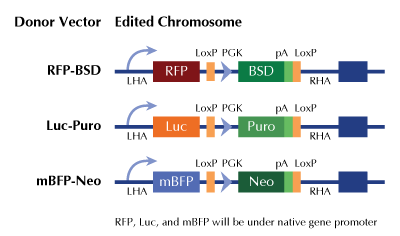C6orf150 (MB21D1) Human Gene Knockout Kit (CRISPR)
CAT#: KN212386RB
MB21D1 - human gene knockout kit via CRISPR, HDR mediated
Functional Cassette: GFP-puro Luciferase-Puro mBFP-Neo
HDR-mediated knockout kit validation
USD 1,657.00
4 Weeks*
Specifications
| Product Data | |
| Format | 2 gRNA vectors, 1 RFP-BSD donor, 1 scramble control |
| Donor DNA | RFP-BSD |
| Symbol | C6orf150 |
| Locus ID | 115004 |
| Components |
KN212386G1, C6orf150 gRNA vector 1 in pCas-Guide CRISPR vector KN212386G2, C6orf150 gRNA vector 2 in pCas-Guide CRISPR vector KN212386RBD, donor DNA containing left and right homologous arms and RFP-BSD functional cassette. GE100003, scramble sequence in pCas-Guide vector |
| Disclaimer | These products are manufactured and supplied by OriGene under license from ERS. The kit is designed based on the best knowledge of CRISPR technology. The system has been functionally validated for knocking-in the cassette downstream the native promoter. The efficiency of the knock-out varies due to the nature of the biology and the complexity of the experimental process. |
| Reference Data | |
| RefSeq | NM_138441 |
| UniProt ID | Q8N884 |
| Synonyms | C6orf150; cGAS; h-cGAS |
| Summary | Nucleotidyltransferase that catalyzes the formation of cyclic GMP-AMP (cGAMP) from ATP and GTP and plays a key role in innate immunity (PubMed:23258413, PubMed:23707061, PubMed:23722159, PubMed:24077100, PubMed:25131990, PubMed:29976794, PubMed:30799039). Catalysis involves both the formation of a 2',5' phosphodiester linkage at the GpA step and the formation of a 3',5' phosphodiester linkage at the ApG step, producing c[G(2',5')pA(3',5')p] (PubMed:28363908, PubMed:28214358). Acts as a key cytosolic DNA sensor, the presence of double-stranded DNA (dsDNA) in the cytoplasm being a danger signal that triggers the immune responses (PubMed:28363908). Binds cytosolic DNA directly, leading to activation and synthesis of cGAMP, a second messenger that binds to and activates TMEM173/STING, thereby triggering type-I interferon production (PubMed:28363908, PubMed:28314590). Preferentially recognizes and binds curved long DNAs (PubMed:30007416). In contrast to other mammals, human CGAS displays species-specific mechanisms of DNA recognition and produces less cyclic GMP-AMP (cGAMP), allowing a more fine-tuned response to pathogens (PubMed:30007416). Has antiviral activity by sensing the presence of dsDNA from DNA viruses in the cytoplasm (PubMed:28363908). Also acts as an innate immune sensor of infection by retroviruses, such as HIV-1, by detecting the presence of reverse-transcribed DNA in the cytosol (PubMed:23929945). Detection of retroviral reverse-transcribed DNA in the cytosol may be indirect and be mediated via interaction with PQBP1, which directly binds reverse-transcribed retroviral DNA (PubMed:26046437). Also detects the presence of DNA from bacteria, such as M.tuberculosis (PubMed:26048138). cGAMP can be transferred from producing cells to neighboring cells through gap junctions, leading to promote TMEM173/STING activation and convey immune response to connecting cells (PubMed:24077100). cGAMP can also be transferred between cells by virtue of packaging within viral particles contributing to IFN-induction in newly infected cells in a cGAS-independent but TMEM173/STING-dependent manner (PubMed:26229115). In addition to antiviral activity, also involved in the response to cellular stresses, such as senescence, DNA damage or genome instability (PubMed:28738408, PubMed:28759889). Acts as a regulator of cellular senescence by binding to cytosolic chromatin fragments that are present in senescent cells, leading to trigger type-I interferon production via TMEM173/STING and promote cellular senescence (By similarity). Also involved in the inflammatory response to genome instability and double-stranded DNA breaks: acts by localizing to micronuclei arising from genome instability (PubMed:28738408, PubMed:28759889). Micronuclei, which as frequently found in cancer cells, consist of chromatin surrounded by its own nuclear membrane: following breakdown of the micronuclear envelope, a process associated with chromothripsis, CGAS binds self-DNA exposed to the cytosol, leading to cGAMP synthesis and subsequent activation of TMEM173/STING and type-I interferon production (PubMed:28738408, PubMed:28759889). Acts as a suppressor of DNA repair in response to DNA damage: translocates to the nucleus following dephosphorylation at Tyr-215 and inhibits homologous recombination repair by interacting with PARP1, the CGAS-PARP1 interaction leading to impede the formation of the PARP1-TIMELESS complex (PubMed:30356214).[UniProtKB/Swiss-Prot Function] |
Documents
| Product Manuals |
| FAQs |
| SDS |
Resources
Other Versions
| SKU | Description | Size | Price |
|---|---|---|---|
| KN212386 | MB21D1 - human gene knockout kit via CRISPR, HDR mediated |
USD 1,657.00 |
|
| KN212386BN | MB21D1 - human gene knockout kit via CRISPR, HDR mediated |
USD 1,657.00 |
|
| KN212386LP | MB21D1 - human gene knockout kit via CRISPR, HDR mediated |
USD 1,657.00 |
|
| KN412386 | MB21D1 - KN2.0, Human gene knockout kit via CRISPR, non-homology mediated. |
USD 1,657.00 |
|
| GA114504 | CGAS CRISPRa kit - CRISPR gene activation of human cyclic GMP-AMP synthase |
USD 1,657.00 |
{0} Product Review(s)
Be the first one to submit a review






























































































































































































































































 Germany
Germany
 Japan
Japan
 United Kingdom
United Kingdom
 China
China
